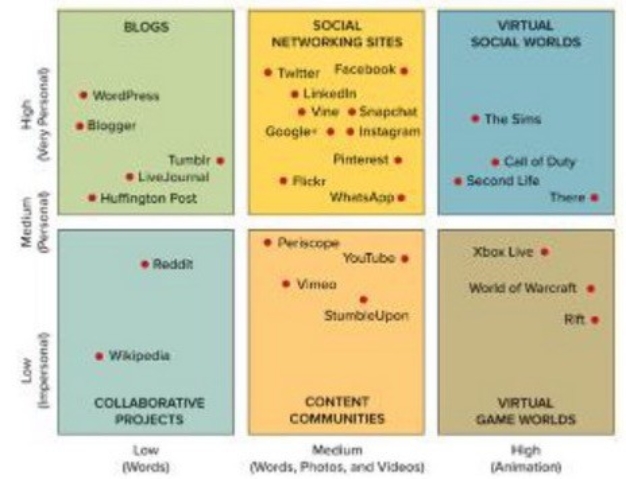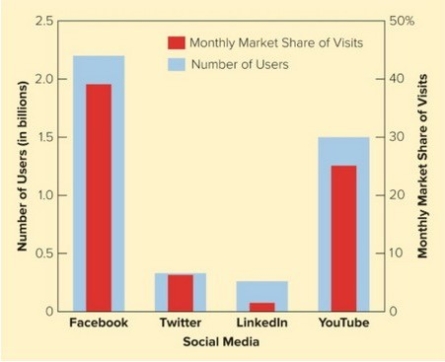A) user-generated content.
B) wikis.
C) net platforms.
D) Facebook pages.
E) social media.
Correct Answer

verified
Correct Answer
verified
Multiple Choice
All of the following are digital metrics used by Body Glove except which?
A) cost per impression
B) e-commerce revenue
C) click through rates
D) app downloads
E) impressions
Correct Answer

verified
Correct Answer
verified
Multiple Choice
As a performance measure for social networks, the number of page views divided by visitors in a given time period is referred to as
A) gross page views.
B) the average page views per visitor.
C) average website hits.
D) the average website view rate.
E) the overall interaction rate.
Correct Answer

verified
Correct Answer
verified
Multiple Choice
In classifying social media, media richness is ________, whereas self-disclosure is ________.
A) the degree to which a person's thoughts, feelings, likes, and dislikes are made public; the degree of acoustic, visual, and personal contact between two communication partners
B) the degree of acoustic, visual, and personal contact between two communication partners; the degree to which a person's thoughts, feelings, likes, and dislikes are made public
C) the quality of the graphics and video on a website; the online conduct that leads to an unfavorable impression
D) a visual measure; an emotional measure
E) the extent to which a user personalizes his/her profile page; adding contact information (telephone, address, and email) on one's Facebook Page
Correct Answer

verified
Correct Answer
verified
Multiple Choice
YouTube would be an excellent social network to advertise all of the following products which?
A) power tools
B) financial services
C) cars
D) deep sea diving vacations
E) blenders
Correct Answer

verified
Correct Answer
verified
Multiple Choice
Which product was an important innovation for Body Glove and the source of inspiration for its brand name?
A) long underwear designed for outdoor activities
B) a virtual surfing game
C) a chemical heat pack
D) a pregnancy pillow
E) a neoprene wetsuit
Correct Answer

verified
Correct Answer
verified
Multiple Choice
The convergence of real and digital worlds has been made possible by all of the following except which?
A) algorithms
B) television
C) databases
D) apps
E) social commerce technologies
Correct Answer

verified
Correct Answer
verified
Multiple Choice
A company paying a set amount to Facebook for every time a user clicks on its ad is using ________ as a performance measure, whereas a company that pays pennies for every 1,000 times its ad loads on a Facebook page and people may see it is using ________ as a performance measure.
A) variable fee; fixed fee
B) cost per click; cost per thousand
C) fixed fee; variable fee
D) cost per action; cost per click
E) traditional cost; social media cost
Correct Answer

verified
Correct Answer
verified
Multiple Choice
 Figure 17-1
-One dimension, ________, is used to classify social media and is shown in Figure 17-1 above on the -axis, ranging from "impersonal" to "very personal."
Figure 17-1
-One dimension, ________, is used to classify social media and is shown in Figure 17-1 above on the -axis, ranging from "impersonal" to "very personal."
A) user-generated content
B) social value
C) self-disclosure
D) media richness
E) emotive content
Correct Answer

verified
Correct Answer
verified
Multiple Choice
As a performance measure for social networks, the click-through rate is
A) the percentage of recipients who have clicked on a link on the page to visit a specific site.
B) the percentage of email recipients who buy the product after receiving a targeted message with an embedded link.
C) the percentage of customers who buy a product from the brand website.
D) the total number of people who have visited a brand's Facebook page and have become Facebook fans.
E) the total number of people who have purchased the product online divided by the number of people viewing the page.
Correct Answer

verified
Correct Answer
verified
Multiple Choice
Online media where users submit comments, photos, and videos often accompanied by a feedback process to identify popular topics are called
A) rich media.
B) Internet channels.
C) avatar channels.
D) social media.
E) feedback loops.
Correct Answer

verified
Correct Answer
verified
Multiple Choice
Each of the following are the four widely used social networks discussed in the textbook based on their impact to both consumers and organizations except which?
A) Twitter
B) YouTube
C) Facebook
D) LinkedIn
E) Instagram
Correct Answer

verified
Correct Answer
verified
Multiple Choice
All of the following statements about user-generated content (UGC) are true except which?
A) UGC is published on a publicly accessible website and created by end users.
B) UGC includes reposting an article found in a newspaper or magazine without editing.
C) UGC is consumer-generated by an individual outside of a professional or commercial organization.
D) UGC shows a significant degree of creative effort.
E) UGC is not simply email, but is published on a publicly accessible website.
Correct Answer

verified
Correct Answer
verified
Multiple Choice
The product life cycle is of most concern for which app?
A) Pandora
B) Pinterest
C) Angry Birds
D) Netflix
E) Bank of America
Correct Answer

verified
Correct Answer
verified
Multiple Choice
Social media can be classified based on ________ and ________.
A) web browsers; apps
B) user-generated content (UGC) ; marketer-generated content (MGC)
C) blogs; wikis
D) textual complexity; visual depth
E) media richness; self-disclosure
Correct Answer

verified
Correct Answer
verified
Multiple Choice
 Figure 17-4
-Recalling Figure 17-4 above, which social network has both the second highest number of users and the second highest monthly market share of visits?
Figure 17-4
-Recalling Figure 17-4 above, which social network has both the second highest number of users and the second highest monthly market share of visits?
A) LinkedIn
B) YouTube
C) Twitter
D) Facebook
E) Pinterest
Correct Answer

verified
Correct Answer
verified
Multiple Choice
The social network that is used solely for sharing videos is
A) Google.
B) Facebook.
C) YouTube.
D) Twitter.
E) LinkedIn.
Correct Answer

verified
Correct Answer
verified
Multiple Choice
In using ________, brand managers can post images of their company's products on their board in hopes that they will be shared on other themed boards, or that users will follow the links back to their websites.
A) YouTube
B) Pinterest
C) Twitter
D) Facebook
E) LinkedIn
Correct Answer

verified
Correct Answer
verified
Multiple Choice
Updates to social media known as ________ include additional functionalities that allow personalization and customization to each individual based on location, interests, and needs.
A) net platforms
B) Web 3.0
C) digital dataworks
D) user platforms
E) peer-to-peer networking
Correct Answer

verified
Correct Answer
verified
Multiple Choice
Although marketers use the term "mobile" to refer to the portability of phones, the term will soon take on new meaning as ________ make change an entire industry of people on the go.
A) laptops
B) text messages
C) social media campaigns
D) wearable technologies
E) connected cars
Correct Answer

verified
Correct Answer
verified
Showing 61 - 80 of 150
Related Exams